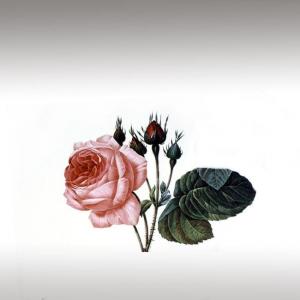
ROSE DE MAI ESSENTIAL OIL (ROSA CENTIFOLIA) - ESSENTIAL OILS

BASE / GENERAL DATA
Information submited: March 12, 2014 Modified: March 15, 2018 By: OperaDreamhouse
Botanical Name: Rosa centifolia
Common Method of Extraction: Solvent Extracted Absolute
Part Typically Used: The petals of various types of rose
Color: Light to medium yellowish-green slightly viscous liquid
Consistency: Slightly viscous liquid
Perfumery Note: Middle
Strength of Initial Aroma: Voluptuous, sweet, smooth, with distinct yet subtle honey and green notes and the soft, delicate sweetness of a fresh bouquet of roses.
Rosa centifolia (hundred leaved/petaled rose).Plants of roses for reproduction and breeding of new varieties were imported in the 18th century from Holland and Belgium, where exterior trade with the Orient permitted the importation of new botanical roses from overseas. Born in France in the 16th century from several crossings of botanical roses, Rosa centifolia or "Cabbage Rose" with its hundred petals, was introduced in Grasse for the production of rose essence.
Rose de Mai has a long and revered aromatic history in the Grasse region and was one of the main aromatic essences distilled and extracted there along with Jasmine, Tuberose, Violet, Neroli and Mimosa. In that special Mediterranean environment all the natural elements were found to grow Rose de Mai to perfection. Even today, though the land devoted to its cultivation is greatly reduced from the golden era in the late 19th and early 20th century, Rose de Mai Absolute of France is considered the finest in the world. The flowers are commercially harvested for the production of rose oil, which is commonly used in perfumery.
Individual plants are shrubby in appearance, growing to 1,5–2 m tall, with long drooping canes and greyish green pinnate leaves with 5-7 leaflets. The flowers are round and globular, with numerous thin overlapping petals that are highly scented. They are usually pink, less often white to dark red-purple.
On the average a single bush produces 250 grams of flowers. The harvest takes plant in May, very early morning(from 4-8 AM) before the dew has disappeared from the flowers. One harvester can pick from 4-10 kilos per hour. After collection, the roses should be processed as soon as possible, otherwise they will wither and give a poor yield on extraction.
Absolute extraction :
In the solvent extraction method, the flowers are agitated in a vat with a solvent such as hexane, which draws out the aromatic compounds as well as other soluble substances such as wax and pigments.
The hexane washes over the flowers and removes from them waxes, volatile oil and pigments. The "washing" takes about 10 minutes and then is pumped off. This process is repeated three times. The three extracts are then collected together and subjected to vacuum distillation which removes the hexane from the solution leaving behind the odiferous waxy concrete. The hexane is saved for future extractions.
To obtain the absolute the concrete is dissolved in warm alcohol and subjected to chilling so that the nonalcohol soluble pigments and waxes precipitate out. The solution is then filtered and subjected to vacuum distillation to remove the alcohol from the solution, leaving behind the absolute.
It takes about 400-500 kilos of Rosa centifolia flowers to make 2,2 lbs of concrete and from the concrete one obtains 1,1 pound of absolute.
Common Method of Extraction: Solvent Extracted Absolute
Part Typically Used: The petals of various types of rose
Color: Light to medium yellowish-green slightly viscous liquid
Consistency: Slightly viscous liquid
Perfumery Note: Middle
Strength of Initial Aroma: Voluptuous, sweet, smooth, with distinct yet subtle honey and green notes and the soft, delicate sweetness of a fresh bouquet of roses.
Rosa centifolia (hundred leaved/petaled rose).Plants of roses for reproduction and breeding of new varieties were imported in the 18th century from Holland and Belgium, where exterior trade with the Orient permitted the importation of new botanical roses from overseas. Born in France in the 16th century from several crossings of botanical roses, Rosa centifolia or "Cabbage Rose" with its hundred petals, was introduced in Grasse for the production of rose essence.
Rose de Mai has a long and revered aromatic history in the Grasse region and was one of the main aromatic essences distilled and extracted there along with Jasmine, Tuberose, Violet, Neroli and Mimosa. In that special Mediterranean environment all the natural elements were found to grow Rose de Mai to perfection. Even today, though the land devoted to its cultivation is greatly reduced from the golden era in the late 19th and early 20th century, Rose de Mai Absolute of France is considered the finest in the world. The flowers are commercially harvested for the production of rose oil, which is commonly used in perfumery.
Individual plants are shrubby in appearance, growing to 1,5–2 m tall, with long drooping canes and greyish green pinnate leaves with 5-7 leaflets. The flowers are round and globular, with numerous thin overlapping petals that are highly scented. They are usually pink, less often white to dark red-purple.
On the average a single bush produces 250 grams of flowers. The harvest takes plant in May, very early morning(from 4-8 AM) before the dew has disappeared from the flowers. One harvester can pick from 4-10 kilos per hour. After collection, the roses should be processed as soon as possible, otherwise they will wither and give a poor yield on extraction.
Absolute extraction :
In the solvent extraction method, the flowers are agitated in a vat with a solvent such as hexane, which draws out the aromatic compounds as well as other soluble substances such as wax and pigments.
The hexane washes over the flowers and removes from them waxes, volatile oil and pigments. The "washing" takes about 10 minutes and then is pumped off. This process is repeated three times. The three extracts are then collected together and subjected to vacuum distillation which removes the hexane from the solution leaving behind the odiferous waxy concrete. The hexane is saved for future extractions.
To obtain the absolute the concrete is dissolved in warm alcohol and subjected to chilling so that the nonalcohol soluble pigments and waxes precipitate out. The solution is then filtered and subjected to vacuum distillation to remove the alcohol from the solution, leaving behind the absolute.
It takes about 400-500 kilos of Rosa centifolia flowers to make 2,2 lbs of concrete and from the concrete one obtains 1,1 pound of absolute.

SPIRITUAL PRACTISES DATA

MEDICINE / HEALTH DATA

BEAUTY / COSMETICS DATA

FOOD / COOKING DATA
COMMENTS
No comments.


